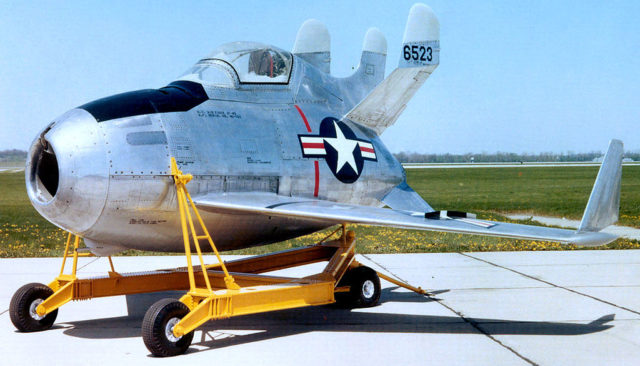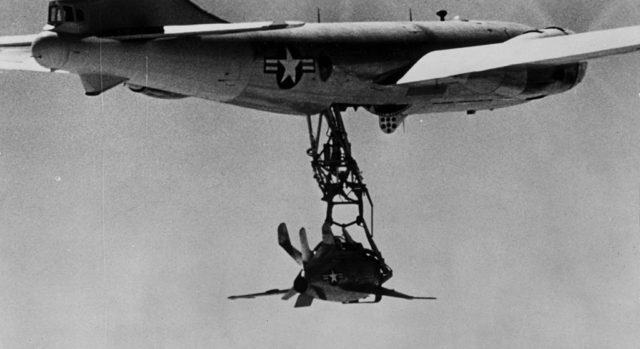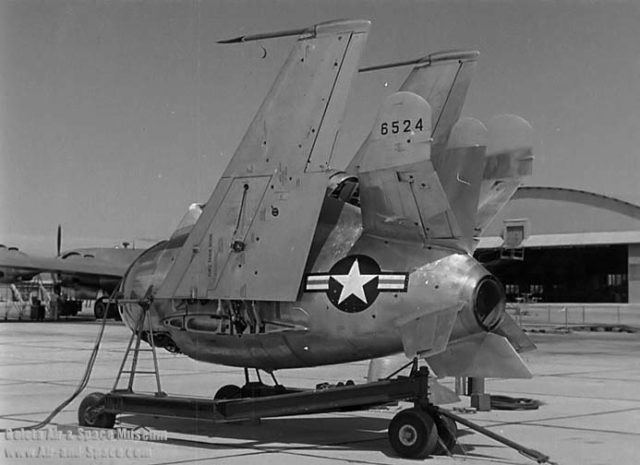The bomber crews operating over Europe could on average have eight or nine sorties before hostile fire would get to them, destroying them in mid-air or forcing them to land and turning the crew into prisoners of war.
Any bomber crew that successfully finished twenty-five missions were considered to have completed their period of duty and could either be discharged or carry on upon personal choice.
As the war continued and the Nazis’ resistance grew vicious and evolved rapidly, Allied forces needed a plan to secure their expensive bombers and, more importantly, their skilled crews.

During the war, a prototype of a smaller “parasite” aircraft surfaced; McDonnell Aircraft conceived the radical idea behind the McDonnel XF-85 Goblin. The idea was to deploy the small fighter aircraft from the bomb bay of the much larger Convair B-36 bomber as a ‘parasite bomber’ to act as a security guard of the bomber.
The Goblin’s role was to carry out defense of the expensive bomber from hostile interceptors behind enemy lines, a need that arose during the Second World War with a significant number of bombers lost to the enemy.
Highly innovative it might be, but there were only two prototypes built and the program was eventually scrapped due to the lack of reliability and other technical problems.
The United States Army Air Force initially came up with the plan for a lighter fighter aircraft to secure the flights of then under constructions bombers XB-35 and B-36.
This need arose from the conflict that emerged from older short-range interceptors and more advanced long-range bombers that were falling outside the operational range of the interceptors which existed at the time. The intended aircraft XF-85 was a strangely shaped machine; a diminutive aircraft with an egg-shaped fuselage fitted with a forked-tail stabilizer design.
The prototypes had already been built and went under testing by the end of 1948. Initially the results that came out of the test flights were promising in terms of performance and design: however, the aircraft lacked the ability to take on the fighter aircraft it would have been facing in the battle, which was a key concern at that time.

During the Second World War, American bombers such as the B-17 Flying Fortress, B-24 Liberator and B-29 Super fortress wreaked havoc on the enemies and were protected by long-range interceptors and escort fighters such as the P-47 Thunderbolt and the P-51 Mustang.
However, when the next generation of bombers came along, the old interceptors could not match their range and the need for an effective long-range fighter emerged; USAAF had to deal with the requirements as the new bombers B-35 and B-36 were considered a treasured asset of the US military and needed adequate protection.
This posed a real challenge to the US engineers as the building of long-range fighters was highly expensive, especially if you consider the fact that aerial fuelling was still a risky endeavor with a host of technical difficulties. On top of that, pilot fatigue was another crucial development in the long-range aircraft that had to be dealt with accordingly and needed extensive planning and of course funds.
The USAAF had a number of different options to choose from; they even considered an idea of remotely piloted vehicles or drones before settling for the parasite design, as it was the only viable and defense for the B-36.
The idea of the parasite aircraft was not new or exclusive to the US military as the British Royal Air Force had already considered such design for their R23 airships as early as 1918. The US military had its own version of the parasite in the 1930s, known as the Curtiss F9C Sparrowhawk that was launched from airships Macon and Akron.

Initially, the XF-85 was seen as quite a stable aircraft with adequate controls over its spins. However, the recovery of the aircraft after it was launched was turning out to be a difficult job for the engineers as the craft had to be hooked back to the bomber through a trapeze during the recovery.
The XF-85 saw its first fully released flight to test the launch and recovery, on Aug 23, 1948, from the Edwards Air Force Base, California. The test pilot of McDonnell, Ed Schoch, released the XF-85 and tried three times to reconnect with the aircraft with no luck.
Each time the turbulence of the giant bomber proved to be a bit too much for the Goblin. During the last attempt, the aircraft hit the trapeze really hard and smashed the canopy; the pilot had to crash land using the craft’s skid on a dry lakebed nearby.
By the time 1949 rolled in, the Goblin had already seen seven test flights and only three of these resulted in successful connection with the bomber’s arresting trapeze.
The test program was later canceled as the need of a parasite aircraft simply vanished with the emergence of Boeing’s KB-29p with its flying boom aerial refueling systems that enabled it to operate long range to escort all kinds of bombers.
